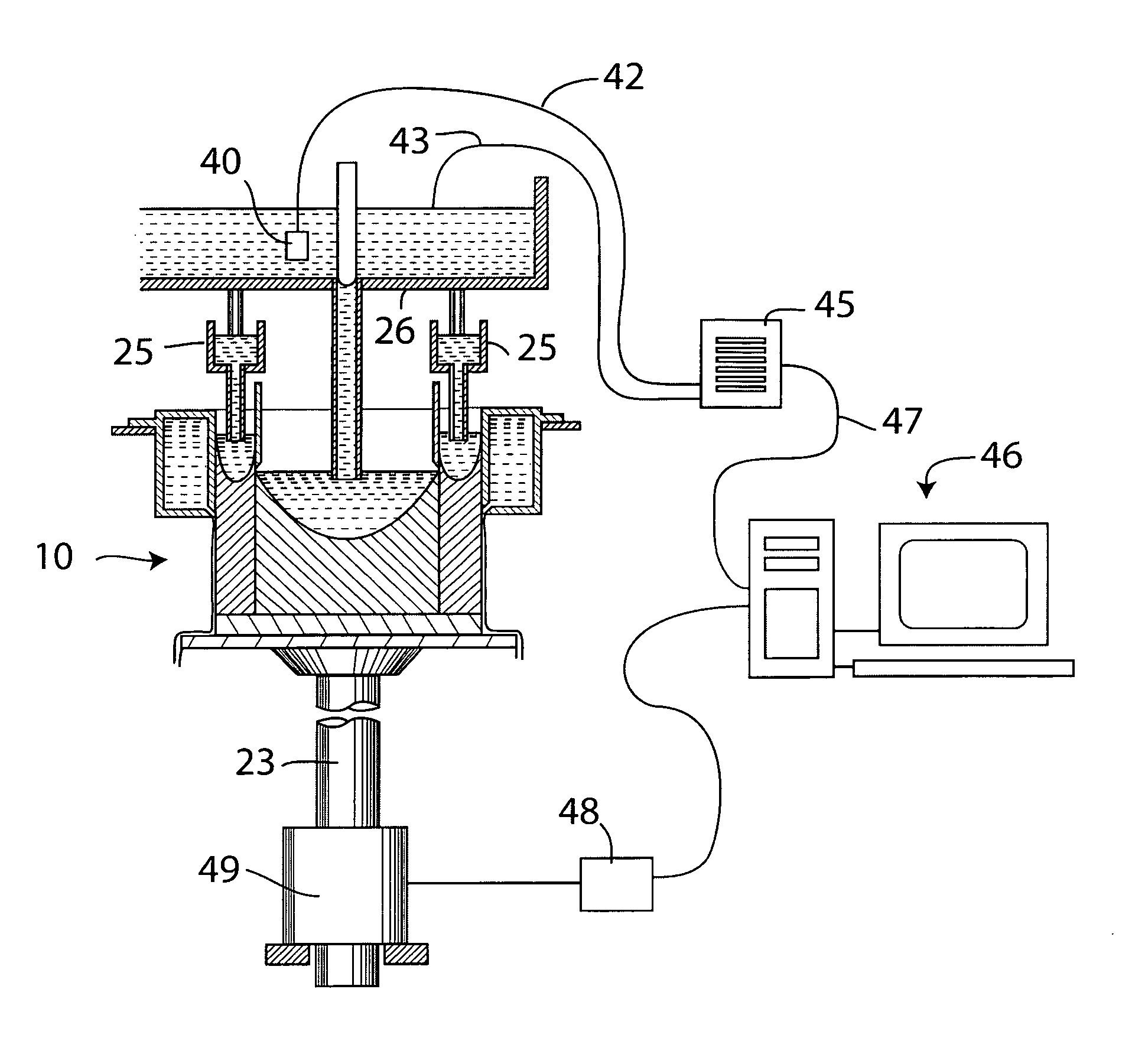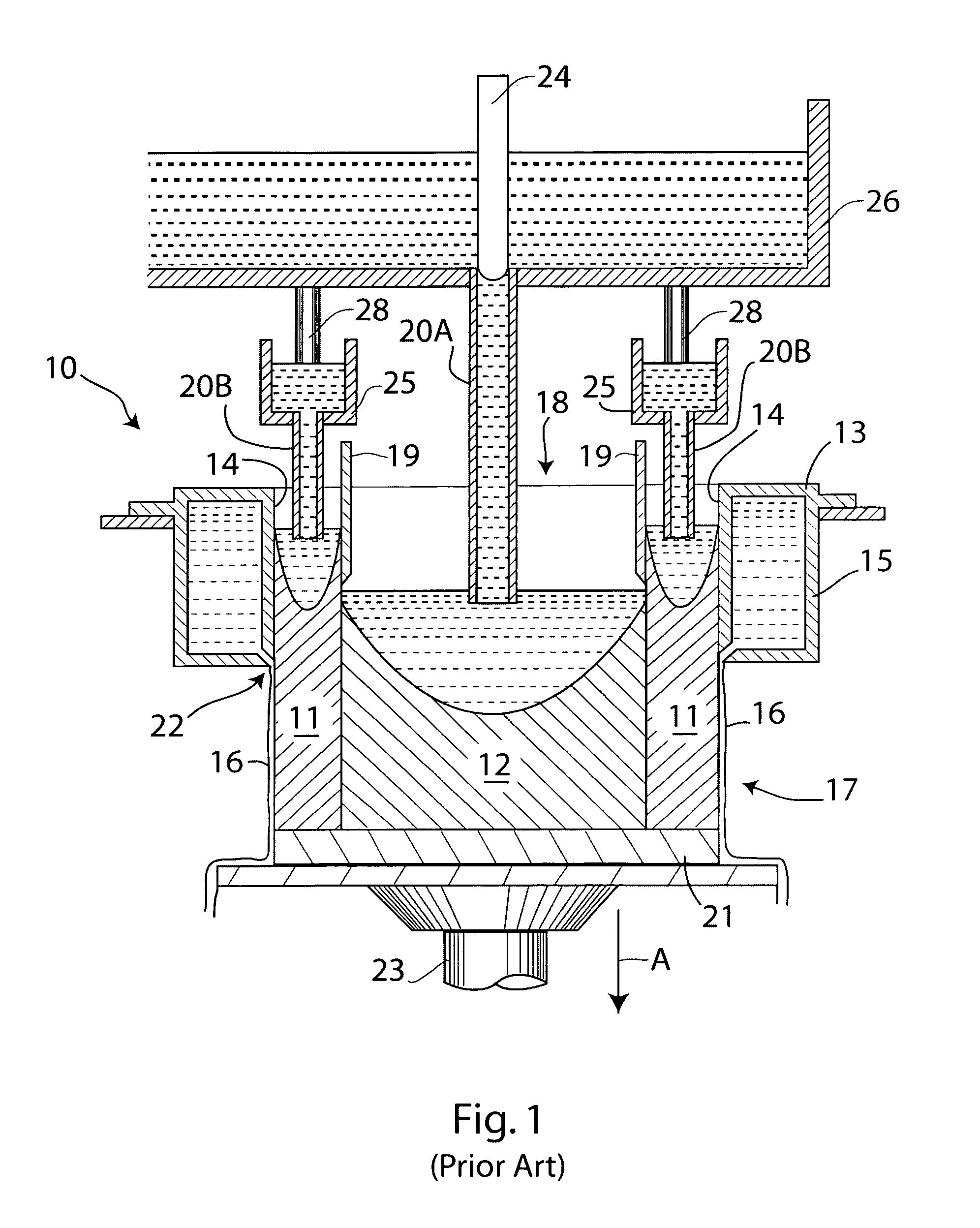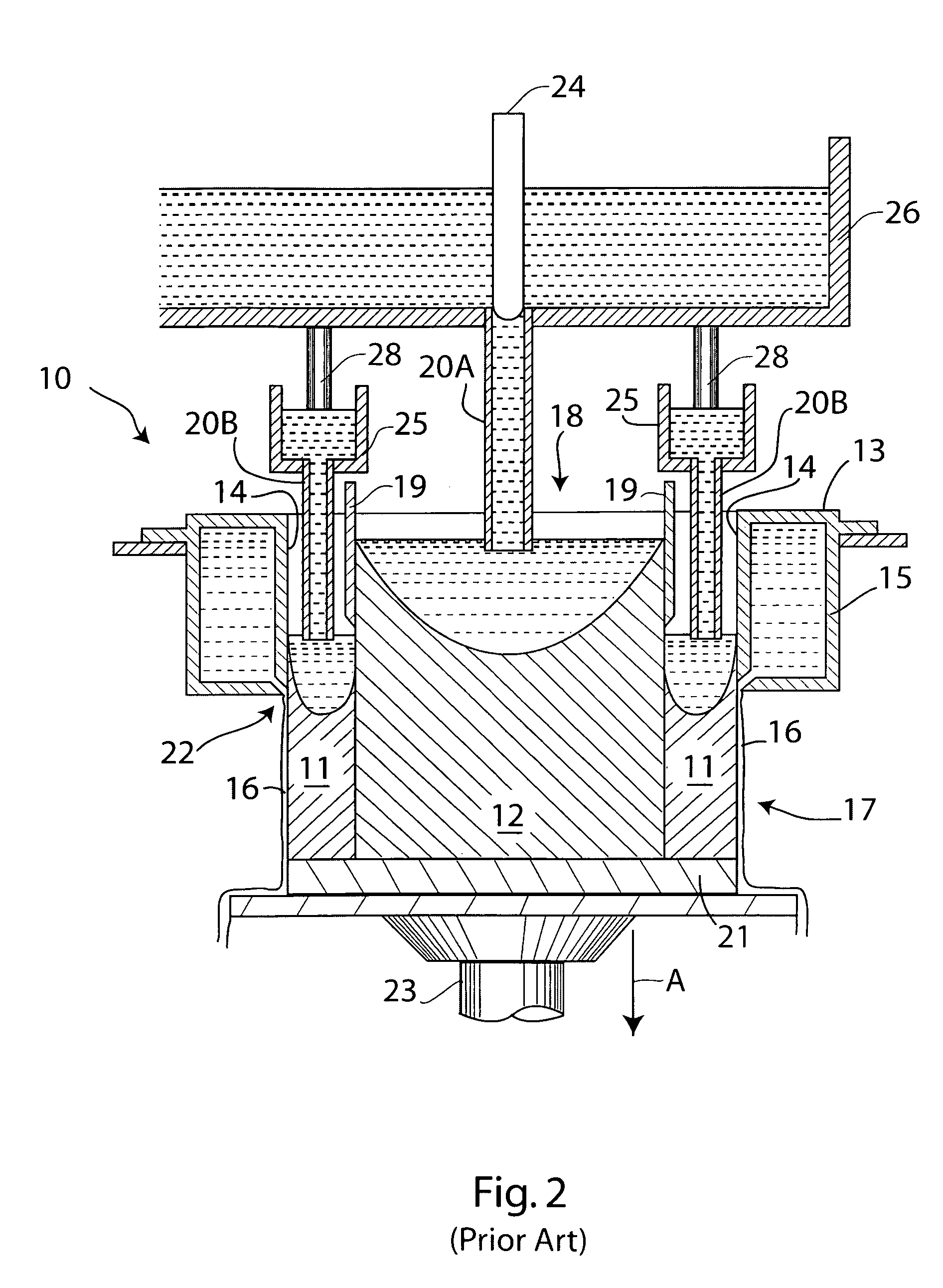One exemplary embodiment of the invention provides a method of direct chill casting a composite metal ingot, which involves sequentially casting at least two metal layers to form a composite ingot by supplying streams of molten metal to at least two casting chambers within a casting mold of a direct chill casting apparatus, monitoring an
inlet temperature of one or more of the streams of molten metal at a position adjacent to an inlet of a casting chamber fed with the
stream, and comparing the monitored temperature with a predetermined set temperature for the stream to detect a
temperature difference from the set temperature, and adjusting a casting variable that affects molten metal temperatures entering or within the casting chambers by an amount based on the one or more of the detected temperature differences to minimize adverse casting effects caused by the one or more temperature differences.
The rate of cooling of the metal streams within the mold (i.e. either increased cooling or decreased cooling) may be varied by adjusting the cooling of chilled divider walls used to separate the chambers of the mold. Typically, the divider walls are made of a heat-conductive metal chilled by water flowing through tubes held in physical contact with the divider walls. Adjusting the rate of flow of the cooling water (and / or its temperature) increases or decreases the amount of heat extracted from the divider wall, and thus increases or decreases the heat extracted from, and temperature of, molten metal in contact with the divider wall. Thus, the temperature of the molten metal in contact with the divider wall is adjusted within the mold itself. The metal in contact with the divider wall eventually forms part of the metal interface between adjacent metal layers and thus the amount of cooling the metal receives directly affects the physical characteristics of the metal at the interface (i.e. the temperature and thickness of a semi-
solid metal shell formed from the molten metal at the interface). Increasing the rate of flow of water through the tubes attached to the divider wall thus increases the rate of cooling of the molten metal in contact with the divider wall, and thus compensates for a temperature of the molten metal above the intended temperature (
set point) as it enters the mold. Conversely, a decrease in the rate of flow of cooling water compensates for a temperature of the molten metal below the
set point.
Similarly, the rate at which cooling water is applied to the exterior of the ingot emerging from the mold may increase or decrease the temperature of the metal within the mold because heat is conducted from the metal within the mold along the ingot to the point where heat is withdrawn by the applied external cooling water. Thus, increasing the flow of cooling water (and / or its temperature) produces an increased
cooling effect on the molten metal within the mold (thus compensating for temperatures above the set point), and decreasing the flow of cooling water produces a relative reduction of cooling (compensating for temperatures below the set point).
Adjustment of the surface heights of the metal pools within the mold chambers has the effect of varying the metal temperature at the interface where the metals contact each other because greater metal depth within a casting chamber increases the time during which the molten metal is in contact with the chilled mold walls and dividers, and shallower metal depth decreases the
cooling time. The metal heights can be adjusted by changing the rate at which molten metal is introduced into the mold chambers, e.g. by moving valves or “throttles” (usually
refractory rods) within the metal supply apparatus. Thus, increased metal depth compensates for temperatures above the set point, and decreased metal depth compensates for temperatures below the set point.
One objective of the adjustment of the casting variables is to prevent rupture, collapse or other failure of the interface where the metals of the cast layers first meet. In sequential casting, a newly-formed metal surface made of semi-
solid metal is employed as a support on which molten metal for an adjacent layer is cast and cooled. The layer of semi-
solid metal is formed as an outer shell around a core of still molten metal, so the shell should be thick enough to avoid rupture or collapse when contacted with the molten metal from the other cast layer. The thickness of the shell is dependent on the time during which the metal layer was cooled, particularly by the divider walls. Furthermore, the temperature of the semi-solid layer should be such that it is not raised into the molten range of temperatures when contacted with the molten metal of the other layer, otherwise the interface may again be subject to rupture or collapse. Thus, the generation of a viable casting interface is very much dependent on the time of cooling and lowest temperature of the first metal to be cast at the point where the cast metals first meet and fully solidify. It is therefore one objective to make adjustments to a casting variable that affects this
cooling time and temperature to compensate for fluctuations in the inlet temperatures of the molten metals around the predetermined set point. Another objective of the adjustment of casting variables is to compensate for poor
metal flow or the introduction of solid or semi-
solid metal artifacts into the casting chambers caused by undue cooling of the metal being introduced. A variable such as casting speed can be used for such compensation as will be apparent from the description below.
A particular feature of the exemplary embodiments is that variations of the inlet temperatures of at least two metal streams are compensated for by the adjustment of just one casting variable, e.g. casting speed, that affects all of the metal layers. The inventors have found that, within predetermined ranges of variation from the set temperatures for the metal streams, a degree of
heat transfer takes place across the metal-metal interface to equalize or minimize the effects of the temperature differences of the various metal streams. For example, if the cladding metal is too hot by an amount greater than the core metal, but is still within the predetermined range, a casting
speed reduction based on the temperature of the core metal will stabilize the metal-metal interface because the super-heat of the cladding layer will be transferred in part to the core layer and will therefore not have the
adverse effect otherwise anticipated. Additional cooling of the cladding metal is therefore not required. It is also possible to adjust the casting variable based on a summation or average of the excess inlet temperatures of both or all of the molten metal streams.
 Login to View More
Login to View More 


